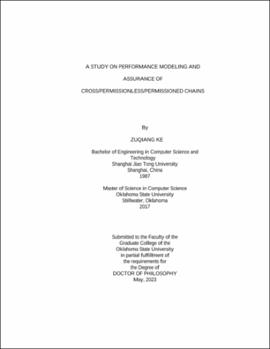| dc.description.abstract | This research addresses and resolves the performance modeling and assurance issues across the full spectrum of blockchain protocols, from permissionless (Chapter II) and permissioned (Chapter III) to cross-chain (Chapter IV). In Chapter II, a queueing model for permissionless blockchains and validations is proposed with respect to specific yet practical characteristics of the blockchains such as Bitcoin and Ethereum, primarily in terms of the block size and its waiting time. A set of variables considered in this model lists the network traffic intensity, the maximum number of transactions in a block, the block time, and the transaction arrival rate, to mention a few. Numerical simulations are conducted, and the efficacy of the proposed model is validated in a quantitative yet practical manner versus Bitcoin and Ethereum. In Chapter III, a set of queueing models for permissioned blockchain, which is considered an emerging technology for a trustworthy decentralized network, is proposed. Hyperledger Fabric is a well-defined permissioned blockchain. It is constructed by various types of nodes, such as the nodes for endorsement, ordering, and commitment, to realize the decentralized nature of trustworthy network operations. Each type of node is characterized in terms of transaction/block queue size and waiting time, and the transaction/block arrival rates and the transaction/block service rates are considered for simulation purposes. It is taken into account how the arrival rates and the service rates co-influence the performance and how the number of channels impact the performance in order to ultimately facilitate a more dynamic way of optimization. The efficacy of the proposed models is demonstrated by the extensive numerical simulations and analyses. In Chapter IV, a cross-chain communication protocol and a m/Cox/1 queueing model-based performance model are proposed. Cross-chain communication considers two distinct types of transactions, such as an atomic swap and an inter-ledger asset transfer. They are controlled by different types of communication mechanisms, namely, Hashed Time Lock Contract (HTLC) based on a pre-image-based technique, and inter-ledger asset transfer, based on an asynchronous verification technique. In the performance model, a Poisson arrival process is assumed, and the two services for pre-commit, verify and commit are assumed to be exponential distributions. Lastly, the selection ratio of a communication protocol between HTLC and the inter-ledger asset transfer is assumed. Extensive numerical simulations are conducted to study the performance impact of changing the parameters, such as arrival rate, service rate, and the ratio of communication protocol. In this research, the proposed models provide a comprehensive yet fundamental basis to assure and ultimately optimize the design of blockchain technology-based applications in specific terms of performance. | |
